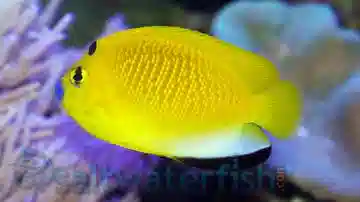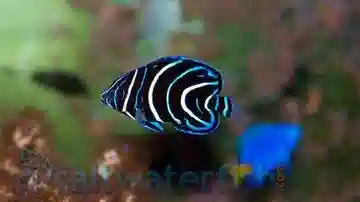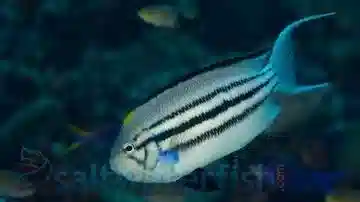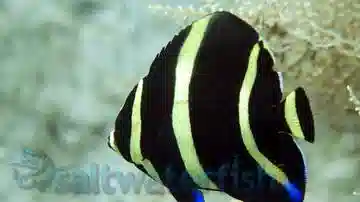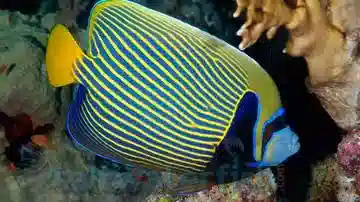Emperor Angelfish
Pomacanthus imperator
(2 Reviews)
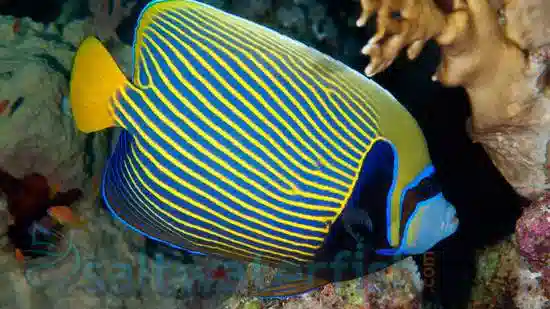
Emperor Angelfish
Pomacanthus imperator
(2 Reviews)
{{ item.name }}
Size: {{ item.extra_field_3 }}
${{ getFormattedPrice(item.saleprice) }} ${{ getFormattedPrice(item.price) }}
To join the waiting list, click here
Free Shipping
With
$199.00
or more in Marine Life.
More details...
Emperor Angelfish Care Facts
| Care Level: | Moderate |
|---|---|
| Temperament: | Semi-Aggressive |
| Diet: | Omnivore |
| Reef Safe: | No |
| Minimum Tank Size: | 120 gallons |
| Max Size: | 15 inches |
Emperor Angelfish
The Emperor Angelfish originates from the Indo-Pacific's warm tropical waters, favoring coral-rich areas, lagoons, and reef slopes, often seeking refuge in crevices and caves. However, it's crucial to note that while stunning, it's not reef-safe, as it may nip at corals, potentially harming the reef ecosystem. In captivity, they can grow up to 15 inches and live for over a decade with proper care, requiring a diverse diet of marine pellets, frozen foods, live algae, and sponges.
This species isn't commonly available through aquaculture, so it's essential to choose reputable suppliers like Saltwaterfish.com for healthy specimens. They can be territorial, so it's best to house them singly or in mated pairs. Tankmates like tangs, butterflyfish, wrasse, triggerfish, and certain damselfish can coexist, given sufficient space. Though sexually dimorphic and undergo color changes from juvenile to adult stages, distinguishing sexes visually can be challenging. To maintain their vibrant appearance, replicate their natural habitat in a tank of at least 120 gallons, with stable water conditions and ample hiding spots.
Habitat
Native to the Indo-Pacific, this angelfish thrives in coral-rich areas, lagoons, and reef slopes, often seeking shelter in crevices and caves. Replicating this habitat is crucial for their well-being in captivity.
Reef Compatibility
Stunning but not reef-safe, Emperor Angelfish may nip at corals, potentially harming the reef ecosystem. Introducing them to reef environments requires careful consideration and close monitoring.
Size and Lifespan
Growing up to 15 inches in length, Emperor Angelfish can live for over a decade with proper care, making them a rewarding long-term addition to your aquarium.
Diet in Captivity
Feeding them a diverse diet of marine pellets, frozen foods, live algae, and sponges is essential for their health and vitality.
Aquaculture and Availability
While not commonly available through aquaculture, sourcing from reputable suppliers like Saltwaterfish.com ensures the health of your angelfish.
Compatibility with Tankmates
Territorial and aggressive towards similar species, it's best to house Emperor Angelfish singly or as mated pairs. Compatible tankmates include tangs, butterflyfish, wrasse, triggerfish, and certain damselfish.
- Tangs and Surgeonfish (Acanthuridae): Tangs are generally compatible due to their different body shapes and feeding habits.
- Butterflyfish (Chaetodontidae): Many butterflyfish species coexist well with the Emperor Angelfish, provided they have enough swimming space.
- Wrasse (Labridae): Wrasses come in various shapes and sizes and can be compatible if chosen carefully.
- Triggerfish (Balistidae): Certain triggerfish species can share a tank with the Emperor Angelfish, with sufficient space and hiding spots.
- Damsel Fish (Pomacentridae): Some damselfish species can be compatible, but their temperament may vary.
Sexual Dimorphism
With no significant visual differences between males and females, distinguishing sexes is challenging.
Coloration Changes
Juvenile Emperor Angelfish sport vibrant blue bodies with vertical yellow stripes, while adults display striking blue-black bodies with bold white and blue rings and a yellow caudal fin.
Tank Requirements
A minimum tank size of 120 gallons, stable water conditions (pH: 8.1-8.4, Salinity: 1.020-1.025, Temperature: 74-78°F), and moderate to strong water flow are essential. Incorporate live rock structures and hiding spots to mimic their natural habitat.
Common Names
Also known as Imperator Angelfish and Emperor Angel.
Very nice Fish indeed
Reviewed by: Ernesto on March 23, 2021
Great looking fish.
Reviewed by: Ernst on March 21, 2021


